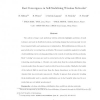Free Online Productivity Tools
i2Speak
i2Symbol
i2OCR
iTex2Img
iWeb2Print
iWeb2Shot
i2Type
iPdf2Split
iPdf2Merge
i2Bopomofo
i2Arabic
i2Style
i2Image
i2PDF
iLatex2Rtf
Sci2ools
ICPADS
2006
IEEE
2006
IEEE
Fast Convergence in Self-Stabilizing Wireless Networks
The advent of large scale multi-hop wireless networks highlights problems of fault tolerance and scale in distributed system, motivating designs that autonomously recover from transient faults and spontaneous reconfiguration. Self-stabilization provides an elegant solution for recovering from such faults. We present complexity analysis for a family of self-stabilizing vertex coloring algorithms in the context of multi-hop wireless networks. Such ”coloring” processes are used in several protocols for solving many different issues (clustering, synchronizing...). Overall, our results show that the actual stabilization time is much smaller than the upper bound provided by previous studies. Similarly, the height of the induced DAG is much lower than the linear dependency on the size of the color domain (that was previously announced). Finally, it appears that symmetry breaking tricks traditionally used to expedite stabilization are in fact harmful when used in networks that are not t...
| Added | 11 Jun 2010 |
| Updated | 11 Jun 2010 |
| Type | Conference |
| Year | 2006 |
| Where | ICPADS |
| Authors | Nathalie Mitton, Eric Fleury, Isabelle Guérin Lassous, Bruno Sericola, Sébastien Tixeuil |
Comments (0)

